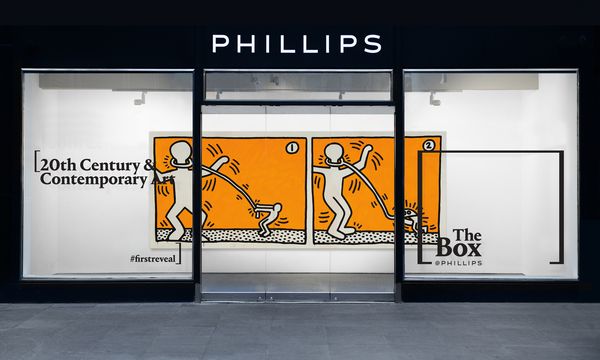Uniting the immediacy of cartoons with the raw dynamism of Art Brut, Untitled, 1984, evinces the precocity of Keith Haring's pioneering approach at only 26 years old. First and foremost a storyteller, the artist furnishes a world of corporeal distortion à la Salvador Dalí, in which one of Haring’s trademark feature-less figures imprisons a much larger one using a rope that then metamorphoses into a snake and turns on its master. Executed on an enormous scale redolent of his cherished murals, Untitled was created after Haring’s rise to prominence for his graffiti drawings in the early 1980s and when he was already a leading figure in New York’s East Village cultural scene, hobnobbing with art world superstars such as Andy Warhol and Jean-Michel Basquiat. Within this community, however, the artist dared to push the boundaries of Pop Art, using idiosyncratic materials such as the vibrant, golden Day-Glo in the present work. Embodying Haring's assertion that "living in 1984, the role of the artist has to be different from what it was fifty, or even twenty, years ago," Untitled blurs the line between high art and street culture using a distinctive visual language that is the artist's alone (Keith Haring, “Untitled Statement,” Flash Art, no. 116, March 1984, p. 24).
Haring publicly protested the injustices of the world he lived in, including racism, war and the AIDS crisis—the disease from which he died at 31. Created the year that Haring joined the international resistance to apartheid in South Africa, Untitled's narrative also appears in another one of his works from 1984, Untitled (Apartheid), Stedelijk Museum, Amsterdam. Haring then utilized the image in a poster and three sets of lithographs in 1985, one of which includes the rope-serpent and another which includes two numbered panels, such as in the present work. Despite evoking the slapstick violence of cartoon, Untitled was, in fact, a crucial element of the development of the artist's anti-apartheid imagery and is a manifestation of Haring's political engagement in 1984.
Haring's oeuvre coalesces distinct eras, geographies and cultures—from the so-called "primitive" art of the Americas to the High Renaissance—and Untitled betrays his preoccupation with the semiotics of Egyptian hieroglyphics and Aztec signs. Reading as two logographs instead of as a single picture, the compositions of Untitled function almost as pictograms and depict figures with no specifying characteristics such as hair, facial features, or attire, thus portraying explicit narratives that are able to be universally and immediately understood. Indeed, Haring wrote in 1979 that "I am intrigued with the shapes people choose as their symbols to create a language. There is within all forms a basic structure, an indication of the entire object with a minimum of lines that becomes a symbol. This is common to all languages, all people, all times" (Keith Haring, January 12, 1979, Keith Haring Journals, New York, 2010, p. 48).
Untitled alludes to the painter's diverse interests in mass media, sociopolitical issues and the evocative capacity of the line, resulting in a superb portrait of his artistic concerns just six years before his death. The difficulty to perfectly assign any one exclusive attribute to the painting—cartoonishly humorous or gravely sincere, ardently political or art-historically referential—is a testament to Haring's ability to imbue his works with a layer of complexity and subjectivity. "I think the greatest feature of a lot of the images is that they're not completely explainable and they can have different meaning for different people." Haring wrote in his journal the day before he executed Untitled. "That's something that man seems to have less and less patience for, but in earlier civilizations symbols were much more versatile" (Keith Haring, October 30, 1984, Keith Haring Journals, New York, 2010, p. 118). Despite its creation surrounding political and artistic matters 35 years ago, the underlying themes of injustice, ambiguity and semiotics in Untitled still resonate today.
Inquiries
Amanda Lo Iacono
Head of Evening Sale
aloiacono@phillips.com
+1 212 940 1278
Browse more highlights from our 20th Century & Contemporary Art Evening Sale >

